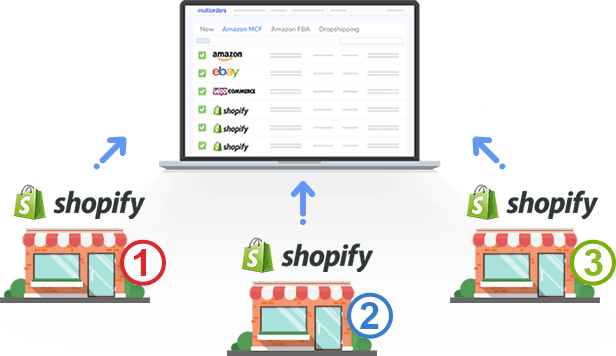As your e-commerce business expands, having multiple Shopify stores cater to your product line and regional markets is a good idea.
Operating Shopify’s multiple stores at the same time will be very difficult. So, a list of best practices will help you run your business with confidence. Follow the following article if you are ready to start running multiple Shopify stores now.
Can You Have Multiple Shopify Stores?
One of the best things about Shopify is that you can start from a small store in an area. Once you’ve grown your business, you can grow into multiple Shopify stores.
Can You Have Multiple Shopify Stores On One Account?
You can’t have multiple Shopify stores under one account, but Shopify allows and supports the use of multiple accounts to run multiple stores. You need to set up accounts for each new store, managing inventory for each through your own Shopify accounts.
Thanks to Shopify’s flexibility, you can create multiple Shopify stores under the same email address. This allows you to send all of your communications to one place.
Build multiple Shopify stores
International Expansion
Being able to expand your store to different countries is nice. However, selling abroad requires a different approach. When going global, you need to have a pretty good grasp of the market you’re entering. Products, store layouts, and advertising will have a different impact in different countries, so having a country-specific store can help you reach individual audiences there. One of the great things about using Shopify stores is that you can set up each one for any market that you’re interested in.
Target different parts of your audience
When you have a Shopify store that sells a variety of products, you want to create different stores for each of your customer segments. You can use subdomains to identify each store while keeping them all under the protection of the main domain.
For example, if you sell strength supplements, you may want to build a store for people who are interested in bodybuilding & fitness supplements and a different store for people who are attentive to alternative remedies & Eastern medicine.
Outletting And Sub-Branding
Establishing sub-brands can be helpful because a successful secondary brand can help promote and reach out to the parent brand. Customers who trust the sub-brand are more likely to try new products released by the parent brand.
You can also create a sub-brand on another Shopify store to sell lower-quality or more affordable products, allowing you to reach new customers without jeopardizing your brand’s reputation. This will help you achieve your retail goals and continue to expand your brand without sacrificing your quality.
Common Challenges With Managing Multiple Shopify Stores
Though having multiple outlets for multiple locations seems like a great idea. But this can be a difficult process to manage and will make your business more vulnerable to security threats. If you are a small business then you can probably handle the data and structure for just one website. But as you grow and begin to diversify your offerings, you quickly find product data confusing.
If you do this precisely and use Google Analytics, you’ll be able to see which sales channels are performing better in different countries and see how they’re split between different product lines. If you sell some products on both sites, you’ll need to keep inventory updated as customers buy and return items to both Shopify stores.
How To Set Up And Manage Multiple Shopify Stores
1. Create And Configure Each Store
Setting up each subsequent store follows the same process. I suggest using the same email address for each store to keep all communications in one place. You can filter your email inboxes by the store to keep them organized.
2. Optimize Each Store For Search
If you sell your products to customers in different countries, each store must be optimized to be relevant to the audience it is targeting. For example, if your target market is South America, you will need to optimize one store for Argentina and another for Brazil.
Each of your main markets will be searching for different products, you won’t use all the same sales keywords and blog topics. You can use local keywords to increase the success of your site in the region. Setting up Google Analytics for each store separately will help you understand the consumption trends in that location.
3. Install A Real-Time Inventory Management System
This allows you to keep track of your inventory and ensure that you always have enough products to meet your customers’ needs. Popular Shopify apps such as Stock Sync can provide low inventory alerts and automatic updates as frequently as once an hour. Customers will appreciate knowing that you always have enough inventory to sell, as well as the ability to quickly see which products are in stock and which are not.
4. Create A Central Order Management System
Centralizing your order management makes managing multi-store purchases and returns simple. You can easily import all of your customer data, including shipping information, refunds, and more, using a Shopify app like ShipHero.
5. Get A Product Information Management System (PIMS)
If you have all of your multiple stores’ products in one warehouse, how does your order fulfillment team know where to look for them? A PIMS manages commodity information in one centralized place for your e-commerce business. It then distributes, updates, and presents that information across all your shops.
Conclusion
I hope this article has given you a better understanding of your Shopify store. If you’re still wondering and need help, don’t worry. At ONEXT DIGITAL, we will support you to develop a Shopify service not inferior to any leading experts in the industry.






